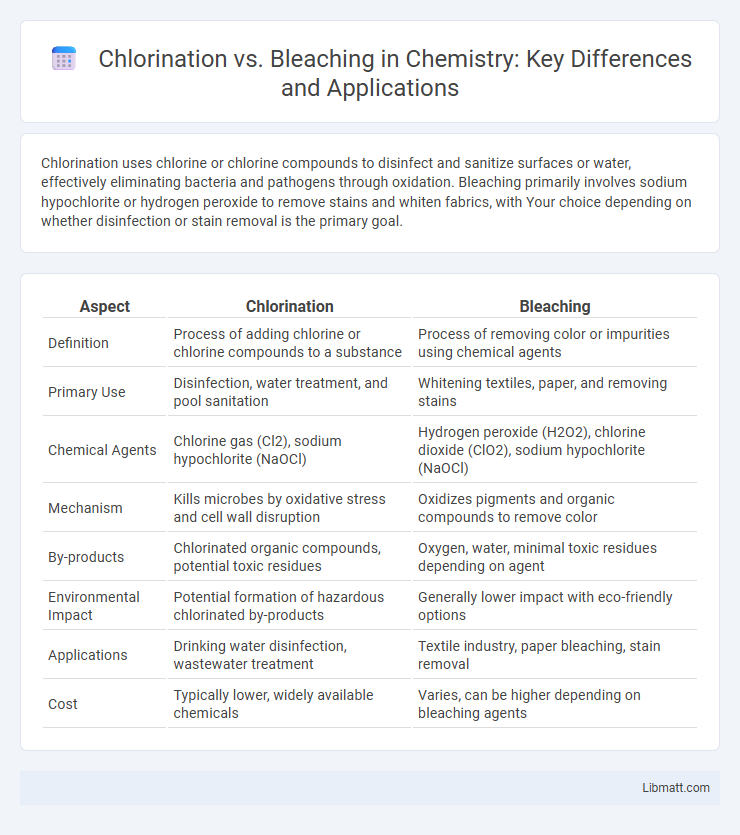Chlorination uses chlorine or chlorine compounds to disinfect and sanitize surfaces or water, effectively eliminating bacteria and pathogens through oxidation. Bleaching primarily involves sodium hypochlorite or hydrogen peroxide to remove stains and whiten fabrics, with Your choice depending on whether disinfection or stain removal is the primary goal.
Table of Comparison
| Aspect | Chlorination | Bleaching |
|---|---|---|
| Definition | Process of adding chlorine or chlorine compounds to a substance | Process of removing color or impurities using chemical agents |
| Primary Use | Disinfection, water treatment, and pool sanitation | Whitening textiles, paper, and removing stains |
| Chemical Agents | Chlorine gas (Cl2), sodium hypochlorite (NaOCl) | Hydrogen peroxide (H2O2), chlorine dioxide (ClO2), sodium hypochlorite (NaOCl) |
| Mechanism | Kills microbes by oxidative stress and cell wall disruption | Oxidizes pigments and organic compounds to remove color |
| By-products | Chlorinated organic compounds, potential toxic residues | Oxygen, water, minimal toxic residues depending on agent |
| Environmental Impact | Potential formation of hazardous chlorinated by-products | Generally lower impact with eco-friendly options |
| Applications | Drinking water disinfection, wastewater treatment | Textile industry, paper bleaching, stain removal |
| Cost | Typically lower, widely available chemicals | Varies, can be higher depending on bleaching agents |
Introduction to Chlorination and Bleaching
Chlorination is a water disinfection process using chlorine-based compounds to eliminate harmful pathogens, ensuring safe and potable water. Bleaching involves chemical agents, primarily chlorine or oxygen-based compounds, to remove stains, whiten fabrics, or sanitize surfaces effectively. Your choice between chlorination and bleaching depends on the application, with chlorination targeting microbial control and bleaching focusing on oxidation and stain removal.
Chemical Processes: How Chlorination Works
Chlorination involves the addition of chlorine or chlorine compounds to water, where chlorine reacts with organic and inorganic substances to form hypochlorous acid (HOCl), a powerful disinfectant. This acid penetrates microbial cell walls, disrupting enzyme functions and effectively killing bacteria, viruses, and protozoa. The chemical process also produces chlorinated byproducts such as trihalomethanes (THMs), which require monitoring due to potential health risks.
Understanding the Bleaching Method
Bleaching involves the chemical process of removing or lightening color from materials, primarily using agents like chlorine or oxygen-based compounds. Chlorination, a specific form of bleaching, uses chlorine or chlorine-releasing chemicals to break down colored molecules, effectively whitening fabrics, paper, and water. Understanding the differences in chemical reactivity, environmental impact, and material compatibility is crucial for selecting the appropriate bleaching method in industrial and household applications.
Applications in Water Treatment
Chlorination is widely used in water treatment for disinfection, effectively killing bacteria, viruses, and protozoa to ensure safe drinking water. Bleaching, primarily using sodium hypochlorite, serves as both a disinfectant and an oxidizing agent to remove organic contaminants and control algae in wastewater treatment. Chlorination provides residual disinfection maintaining water safety during distribution, while bleaching is favored for its rapid action and suitability in industrial and municipal water purification processes.
Effectiveness in Disinfection
Chlorination is highly effective in disinfection due to its ability to kill a wide range of pathogens, including bacteria, viruses, and protozoa, making it a preferred method for water treatment. Bleaching, primarily using sodium hypochlorite, also serves as a powerful disinfectant but is generally more suitable for surface cleaning and smaller-scale applications rather than extensive water purification. Your choice between chlorination and bleaching should consider the specific disinfection needs and the target environment to ensure optimal pathogen removal.
Safety and Health Considerations
Chlorination involves using chlorine gas or compounds that can release harmful fumes, posing respiratory risks and skin irritation if not handled properly. Bleaching agents like sodium hypochlorite can cause chemical burns and release toxic gases when mixed with other substances, requiring careful storage and usage guidelines. You should always wear protective gear and ensure proper ventilation to minimize health hazards associated with both chlorination and bleaching processes.
Environmental Impact Comparison
Chlorination releases harmful byproducts such as chlorinated organic compounds and dioxins, which can persist in water and soil, causing long-term environmental damage. Bleaching, especially using oxygen-based agents like hydrogen peroxide, tends to break down into water and oxygen, resulting in a lower ecological footprint. Choosing bleaching methods over chlorination can significantly reduce toxic waste and protect aquatic ecosystems, making your cleaning or purification process more environmentally responsible.
Cost Analysis: Chlorination vs Bleaching
Chlorination typically incurs lower upfront costs compared to bleaching due to cheaper chemical prices and simpler application methods, making it a cost-effective option for large-scale water treatment. Bleaching, while more expensive per unit, offers faster disinfection with reduced formation of harmful by-products, potentially lowering long-term treatment and regulatory compliance costs. Your choice between chlorination and bleaching should weigh initial expenses against operational efficiency and safety outcomes to optimize overall water treatment budget.
Pros and Cons of Chlorination
Chlorination effectively kills bacteria and viruses, making it a widely used disinfectant for drinking water and swimming pools. However, it can produce harmful byproducts like trihalomethanes (THMs), which are linked to health risks such as cancer and respiratory issues. The chemical's strong odor and potential to cause skin and eye irritation are additional drawbacks that require careful management during application.
Choosing the Right Method: Key Factors
Choosing the right method between chlorination and bleaching depends on factors such as the intended use, environmental impact, and safety requirements. Chlorination is effective for disinfecting large-scale water supplies but can produce harmful byproducts, while bleaching offers strong whitening capabilities primarily for textiles and household cleaning. Evaluating your specific application and regulatory guidelines ensures you select the method that balances efficacy, cost, and health considerations.
Chlorination vs bleaching Infographic

 libmatt.com
libmatt.com